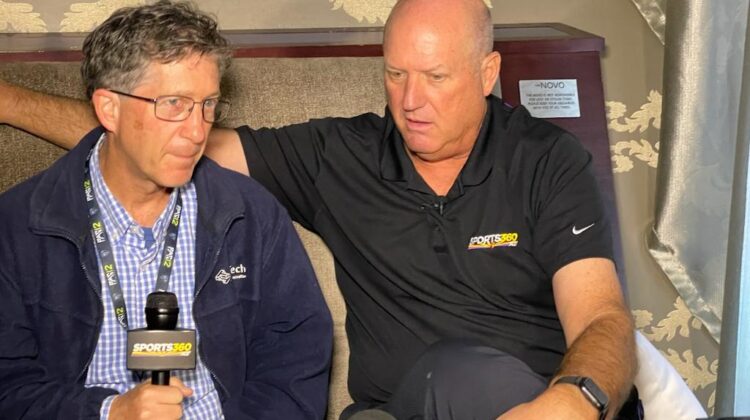Please note: Some questions have been edited for clarity and brevity.
You said that eventually some Pac-12 teams will leave for the Big 12, just not now since the Big Ten isn’t expanding soon. Is there anything the Pac-12 can do in the meantime to prevent those schools from leaving? — @hmckee53
In my vision of the future of the sport, Arizona, ASU, Colorado and Utah are destined for the Big 12. But let’s be clear with the specifics on two fronts.
If the conference adds Oregon, Washington, Stanford and Cal to form a six-school western division (with USC and UCLA), the Pac-12 will dissolve. But there are three possible windows for the rupture:
1. This fall, which seems unlikely.
2. The end of the decade, as the Big Ten prepares for its next media contract.
3. The middle of the 2030s, when the ACC’s grant-of-rights agreement expires.
It’s entirely possible that the reconstituted Pac-12 will survive for another 10-15 years. In fact, that outcome is more likely than a collapse in the next few months.
*** The future Big 12 won’t be the Big 12 as we know it.
Instead, it will be a coast-to-coast receptacle for any Power Five programs that aren’t future members of the Big Ten or SEC.
Sure, we see the Pac-12 eventually fracturing, but the ACC will do the same. The choice schools (Virginia, North Carolina, Duke, Clemson, Florida State and Miami) will eventually join either the SEC or the Big Ten.
In other words, the implosion of the current conference structure is not specific to the Pac-12. It’s the result of an inevitable, systemic change — one fueled by the quest for media dollars — that impacts every conference in some fashion or another.
The Big 12 could lose a team or two, as well. Kansas would be atop our list of likely departures, followed by Oklahoma State and Houston if the SEC and Big Ten end up as 24-team leagues.
But when the shaking subsides, the Big 12 will be reformed, perhaps renamed and home to 20-to-24 schools that are broken into four divisions.
The long-haul structure for college football, in that scenario, will feature an expanded Big Ten, an expanded SEC, a huge Big 12 and then a series of conferences crafted from the current Group of Five.
Do you think the change in tone from the Big Ten (signaling a pause to expansion) is sufficient to get Pac-12 schools to sign a new grant-of-rights deal soon? Or do some hold out to see the deal? — @OskiDeLaHoya
Those issues unfold concurrently — they are separate documents, after all.
Commissioner George Kliavkoff will create the best media rights deal possible and take it to the presidents for approval.
If it’s satisfactory, the schools will sign their grant of rights over to the conference, then sign the media contract. If the deal on the table isn’t sufficient, they won’t sign the grant of rights.
As Kliavkoff explained recently on ‘Canzano and Wilner: The Podcast‘: “I think (they) will sign a grant-of-rights agreement if we put the right agreement in front of them.”
In our view, Kliavkoff offered that candid assessment because he’s fairly confident of a positive outcome.
Does the Big Ten pushing pause mean the Big 12 will stop lobbing grenades, as well? –@bogeycat85
It’s interesting how Big Ten commissioner Kevin Warren and Big 12 commissioner Brett Yormark have struck similar tones about expansion in the three-and-a-half months since USC and UCLA rocked the Pac-12.
Both were aggressive with their remarks over the summer, adding to the perception of instability in the Pac-12, but lately, both have tempered their public statements. (It almost looks coordinated.)
Yormark’s stance at the time was understandable because his conference is, in some ways, at a significant disadvantage relative to the Pac-12.
The 2024 expiration of the Pac-12’s media rights contract means it is currently engaged in formal negotiations with interested parties. It can talk hard numbers and present contract terms to its members. The Big 12 cannot because of a contract that doesn’t expire until 2025.
Yormark is trying to change that dynamic and enter into early negotiations with his partners. From what we understand, that step hasn’t materialized yet.
Will the “grenades” subside? We cannot say. Just be aware of what you read and where you read it.
If Notre Dame stays Independent, does any realignment happen at all? — @RChalk94
The Hotline does not believe Notre Dame will join a conference as long as the Irish have reasonable access to the playoff and their next media contract meets revenue expectations.
We expect both criteria to be met.
But Notre Dame’s continued position as an Independent won’t stop realignment. Once the Big Ten’s new media rights contract expires in 2030, the conference will decide to grow again — and its broadcast partners will have the means and the interest to pay for additional inventory.
Put another way: Notre Dame’s status has limited the scope of realignment right now, but it won’t stop the next wave.
I always thought Oregon would want to go the Independent route. The Ducks could schedule who they like and, if they’re the true national brand they say they are, it would be a good fit. What say you? — @PW4170
We say that would be a bad idea. Oregon has a national brand, but not of the size and influence that would command the media revenue needed to compete for a championship.
In that regard, the Ducks are more like Brigham Young than Notre Dame, and look where the Cougars are heading: into the Big 12.
Life as an Independent isn’t easy, particularly with scheduling. Everyone wants to play Notre Dame, but again, the Irish are unique. Brigham Young has just five games against Power Five opponents this season, and we see no reason Oregon’s situation would be any different if the Ducks made the jump.
Do the upcoming changes in the Pac-12 seem to be impacting recruiting? If so, how? — @MattRexroad
We haven’t seen a dramatic shift from what you would expect given the lineup of head coaches. For example, USC’s recruiting has improved markedly, but that’s the result of hiring Lincoln Riley, not moving to the Big Ten.
That said, it’s far too early to draw conclusions.
At this point in the 2022-23 recruiting cycle, prospects are allowed to make non-binding verbal commitments. Those are often broken, either by the player or the school.
The true gauge of material change resulting from the departures of USC and UCLA or instability within the remaining members will come during the early signing window (Dec. 21-23).
And we will be tracking that situation closely.
Will the conference stick with the division format for games next year, now that division winners don’t go to the championship? Or will that change for the final season with the L.A. school? — @Pyperkub
Although the conference has scrapped the divisions as a means of recording results and determining which teams will play in the Pac-12 championship game, it retained the schedule that was used under the division format: The two misses for each team are opponents from what was the other division.
The Hotline has not confirmed the plan for 2023 but strongly believes the conference will stick with that format, then shift to a different schedule rotation for 2024 and beyond, depending on the membership configuration (i.e., expansion).
That’s far easier than crafting a different schedule for next season, with the L.A. schools, then changing again for 2024.
Could the Pac-12 have a different set of rules for conference play to make it unique, like abandoning the kickoff and implementing XFL-style ideas? — @NIRVANwA
We like the outside-the-box thinking, but the Pac-12 can’t change the rules, and here’s why: The NCAA is responsible for the playing rules, just as it oversees the recruiting and competition calendars.
The rules for one conference are the same as for all others, even in conference games.
Should Arizona State and Colorado wait for the new media deal before hiring new coaches? Seems like the coaching budgets will be pretty directly connected to the media revenue. — @chriswaz
ASU and Colorado must have head coaches in place by early December, before the early signing window, so they don’t lose an entire recruiting class. And I’m not sure the media rights agreement will be completed by then — the process could seep into 2023.
But two months from now, the schools should have a solid grasp of the media revenue and will be able to build their budgets off that number.
Frankly, the Hotline is of the mindset that both schools should spend whatever money is necessary to hire the best coach (and staff), then cut from elsewhere if cuts are required.
As significant as football success is to athletic departments these days, it will take on even greater importance under the next media contract cycle because of the growing revenue disparity within the Power Five.
Winning games (and filling your stadium) is one of the few ways to limit the gap.
Support the Hotline: Receive three months of unlimited access for just 99 cents. Yep, that’s 99 cents for 90 days, with the option to cancel anytime. Details are here, and thanks for your support.
*** Send suggestions, comments and tips (confidentiality guaranteed) to pac12hotline@bayareanewsgroup.com or call 408-920-5716
*** Follow me on Twitter: @WilnerHotline
*** Pac-12 Hotline is not endorsed or sponsored by the Pac-12 Conference, and the views expressed herein do not necessarily reflect the views of the Conference.
Related posts:

(AP Photo/Ralph Freso, File)
Wilner Hotline – Pac-12 survival guide: The strategic merits of an alliance (or merger) with the Big 12 Wilner Hotline mailbag: UCLA realignment case study, media options for ‘Pac-14,’ expansion whiff, latest on the lawsuit and more
Wilner Hotline mailbag: UCLA realignment case study, media options for ‘Pac-14,’ expansion whiff, latest on the lawsuit and more

Southern California guard JuJu Watkins,(AP Photo/Mark J. Terrill)
Pac-12 WBB Preview – UCLA vs USC at the top, tough competition and rivalries
Washington head coach Kalen DeBoer (AP Photo/David J. Phillip)
Wilner Mailbag: Washington as “flash in the pan,” ACC risks for Stanford and Cal, next moves for the ‘Pac-2’ and more

